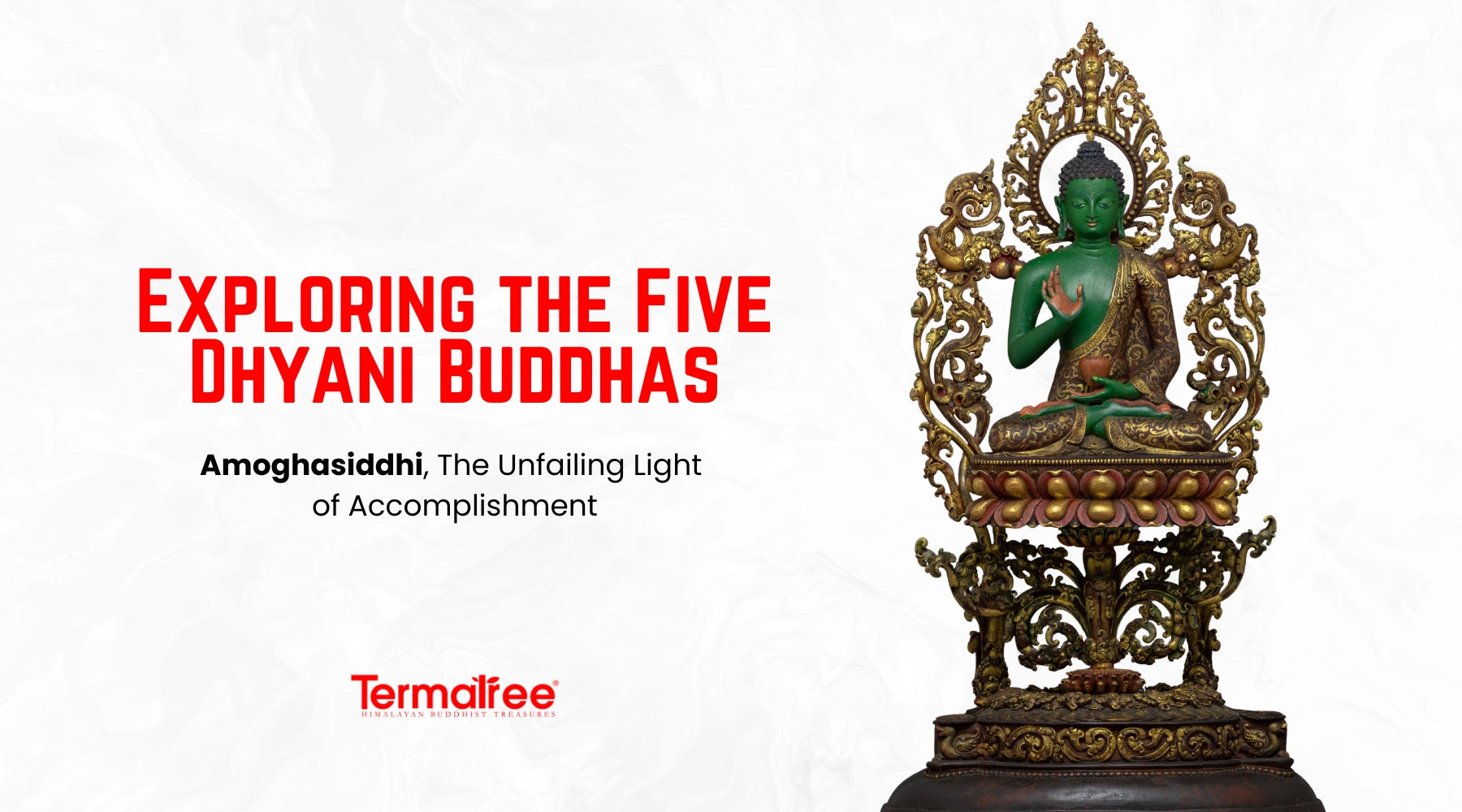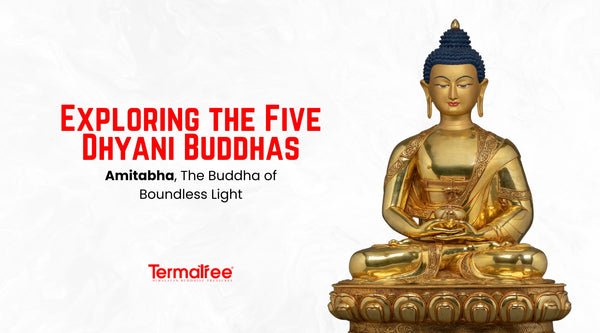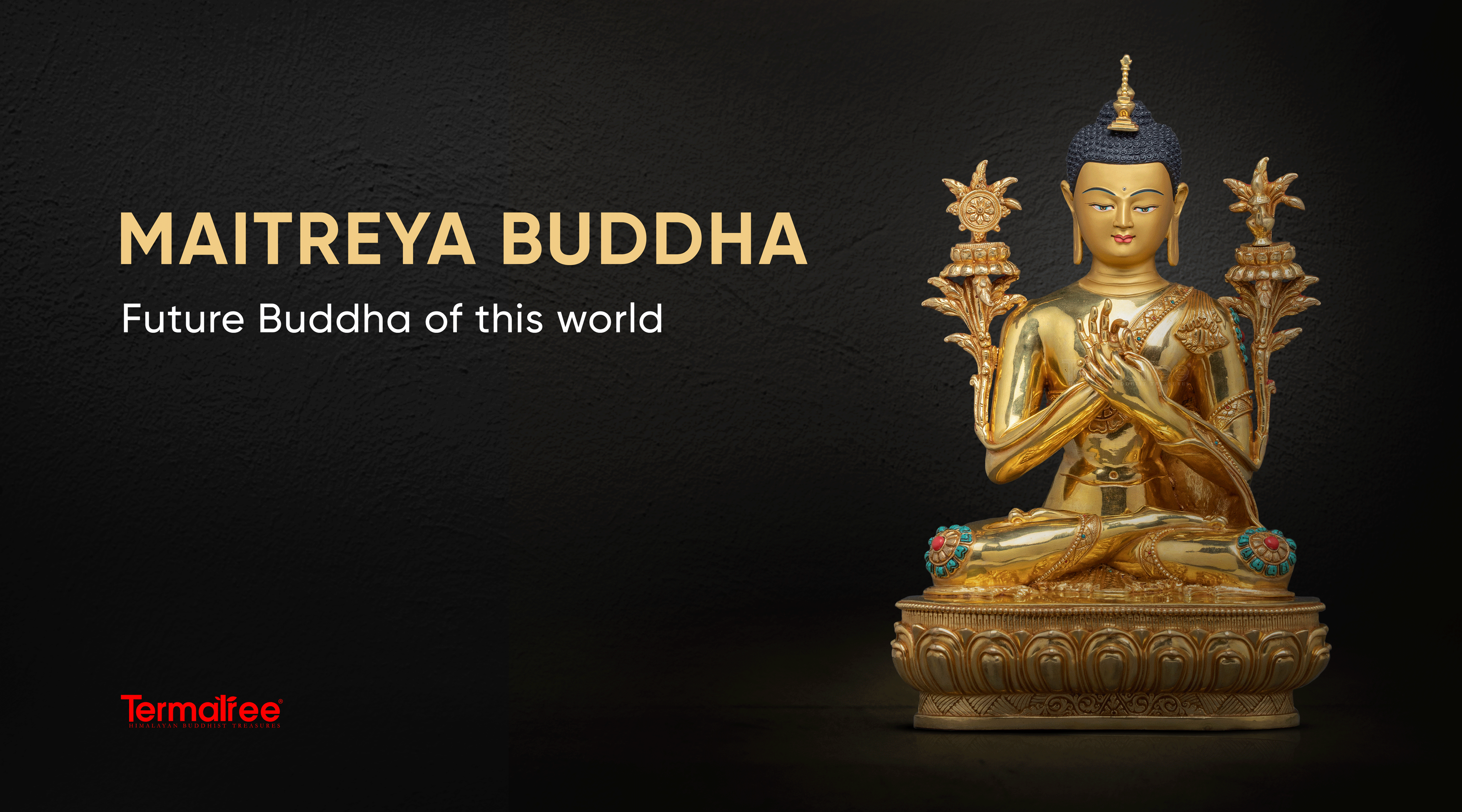Introduction: Manifesting Fearlessness and Purpose
Amoghasiddhi is one of the Five Dhyani Buddhas in Mahayana and Vajrayana Buddhism, representing enlightened activity and accomplishment without fear. Amoghasiddhi translates to "Unfailing Accomplishment" or "He Who Hits The Goal Without Fail" and is derived from two Sanskrit words - Amogha (meaning "unfailing", "infallible") and Siddhi (meaning "accomplishment"). He is not just a symbol of accomplishment - he is a living current of spiritual life, both inner and outer, for millions of us. His green form, calm and yet potent, relates to the direction of North in mandalas, where he is responsible for eliminating our tendency toward envy, fear, and indecisiveness (and through his own lived wisdom, he transforms these into all-accomplishing wisdom).
This blog will explore the various levels of meaning associated with Amoghasiddhi Buddha, his iconography, rituals, and significance in meditation. By considering Himalayan art, Tibetan teachings, and modern ways of interpreting his life-affirming presence, we can appreciate this Buddha of the Karma Family.
The Meaning Behind “Amoghasiddhi”

The name Amoghasiddhi is a combination of Amogha (infallible, unfailing) and Siddhi (success, realization). Taken together, it means “He Whose Accomplishment Is not in Vain,” representing a wisdom that reaches meaningful ends with few, if any, failings. This "success" is not only worldly, but it is also spiritual, based on compassion and clarity. He represents fearless, effective energy that overcomes challenges and directs all actions towards true liberation and benefit.
Iconography: Symbol of Fearlessness
Amoghasiddhi Buddha's iconography embodies rich symbolism that is relevant to his qualities of enlightenment. Although from his green color to the double vajra on the underside of his seat, everything comprises his form as a reminder to practitioners of his fearlessness, power of transformation and activity, and active compassion.
1. Radiant Green Body: The Color of Transformation
Amoghasiddhi's vivid green body will be immediately recognizable, and it represents the element of air or wind, and is clearly suggestive of movement, action, and transformation. Green can also represent his transformation of jealousy into all-accomplishing wisdom, which is the most relevant aspect of his enlightened mind. Amoghasiddhi's green body radiates energy and fearlessness as an activity, unlike the passive red or blue bodies of some other Buddhas; he embodies wisdom at work.
2. Abhaya Mudra: The Gesture of Fearlessness
The defining hand gesture of Amoghasiddhi (Abhaya Mudra) is performed with his right hand raised to shoulder-level, palm facing out. This is the gesture for fearlessness, offering neutrality and protection to anyone with conflicting feelings, anxieties, or doubts. His left hand is usually shown left untouched and resting in his lap in Dhyana Mudra, indicating a deep awareness of serenity and contemplation. Collectively, they show a perfect sense of alignment between inner stillness and outward action, which is an outstanding example of enlightened activity.
3. The Vishvavajra: Symbol of Unshakable Power
Underneath his lotus throne is depicted the vishvavajra, or double cross vajra. Together, they serve as stability and invincibility in all directions. The vishvavajra is associated with Amoghasiddhi's connection to the space element. It also serves to reinforce the purpose of dissolving outer and inner obstacles across realms. Usually, in art, you can find the vishvavajra carved into a pedestal, or emanating light underneath him, forming a base for his endless being.
4. Supported by Garuda: The Devourer of Poison
In many traditional thangkas and statues, Amoghasiddhi has a platform based on the mythic Garuda, a bird deity who, in the same stories, can devour serpents. The serpents can be associated with greed, deceit, and envy. The Garuda here is acting as a spiritual boost to Amoghasiddhi's authority to devour the poisons of the mind and free beings from suffering. In some artwork, nagas, or serpent spirits, can also be found, adding a second protective layer around his platform.
5. Crown and Bodhisattva Ornaments
Amoghasiddhi is a fully enlightened Buddha but still possesses the royal resplendence of a bodhisattva fit to rule the universe solar system as he dons silken robes, jeweled earrings, armlets, anklets, and a five-pointed crown. The five-pointed crown demonstrates his unwavering relationship with the other four Dhyani Buddhas and the wiser union of the five families. His royal adornments represent spiritual regalness, but they also represent the quality of simple merit and meditative practices that allow the awakening of the beholder to the potential they have.
6. Manifestations and Tantric Forms
Although Amoghasiddhi is usually depicted in a peaceful and meditative manner, some tantric lineages depict him in wrathful representations, like Vajrakarma. While in earthly appearances, his form becomes fierce. His eyes blaze, his fangs bear, and he is typically embraced by flames. This intense form represents a force of compassion where fear and ignorance are extinguished in its wake. Wrathful representations of this buddha underscore the theme that compassion can protect in very potent, creative, and raw forms.
7. Harmonious Union: Amoghasiddhi and Green Tara
In peaceful representations of Amoghasiddhi, he is occasionally shown with Green Tara by his side, the swift savior and female expression of active compassion. With Green Tara near, the relationship of wisdom and activity can be seen. Even more, their union sharing responsibility represents an integrated, enlightened activity engaged in a socially responsible environment. In Vajrayana teachings, the inclusion of a consort usually means a more profound and ultimate union of method and wisdom, realized with merit on the path.
6. Artistic Depictions in Himalayan Art
Amoghasiddhi in Himalayan art is typically depicted seated on his lotus throne, surrounded by a glowing green aura. He is sometimes described in northern positions on mandalas and in sculpture is shown as bronze, a copper alloy, sometimes gilded in gold, occasionally inlaid with green stone such as jade or emerald to signify the elemental. His presence in thangkas is as calming and powerful, richly ornamented with finely detailed elements, and softly blending tones that evoke strength and gentleness.
Amoghasiddhi in the Five Dhyani Mandala
He is located in the north of the five Dhyani Buddha mandalas. The north position suggests the protector or pure karmic place - the realm of action and energy. The Five Buddhas, who represent the five directions, colors, families, and wisdom, are, however, not Amoghasiddhi:
-
Direction: North
-
Color: Green
-
Element: Air or Wind
-
Wisdom: All-Accomplishing Wisdom
-
Affliction Transformed: Jealousy and Envy
-
Mudra: Abhaya (Gesture of fearlessness)
-
Buddha Family: Karma Family
The Karma Family is the constellation of the Dhyani Buddha that embodies the dynamic action, energy, and ultimate spiritual success. The energy of the accomplished one embodies the completeness of rapid action, or rapid completion, while avoiding external and internal obstacles. Amoghasiddhi can be visualized in the mandalas as he is depicted as radiating glowing green light, to provide peace and power of all orientations.
Mantra of Amoghasiddhi
The mantra of this deity is a seed of transformative energy:
Om Amoghasiddhi Ah Hum
This mantra can be incorporated into visualization practice, through staying with the visualization of oneself receiving the green light of Amoghasiddhi, who embodies the overcoming of fear and jealousy and karmic obstruction.
In some schools, Amoghasiddhi may be given as part of the complete Five Buddha Mandala Yoga, a complete tantric practice by which the practitioner can begin to internalize the meaning of each of the five wisdoms. During sadhana - tantric ritual practice - the practitioner visualizes the deity, who is expressed in green, located at the north point of the mandala, because his color expresses powerful waves of purifying energy. His fearless mudra acts as a psychic shield that protects the mind from harmful thoughts and influences from others.
Amoghasiddhi in Vajrayana Texts
Amoghasiddhi appears in many tantras and sadhanas throughout the Vajrayana literature. He is an essential part of the Five Buddha Mandala in the Guhyasamaja Tantra and some other esoteric traditions, to help the practitioner disassemble dualistic perception.
He also appears in the Medicine Buddha Mandala in Tibetan traditions and in some Mahakala practices, where he is invoked in a variety of experiences. For example, they are transformations in the year 2022 of the pandemic and ongoing environmental and social functioning. He keeps your energy to empower actions that do not come from ego, but from interdependence.
Rituals and Offerings to Amoghasiddhi
Amoghasiddhi is often used in practices where there will be some sort of activity, or where there needs to be some cleaning. Here are some examples:
-
Obstacle-clearing rituals: To activate the part of the person that is fearless to clear obstacles, both internally and externally.
-
New beginnings: To use his energy to help with the successful provision of activity.
-
Mandala offerings: Particularly those that relate to the Five Dhyani Buddhas.
Some common forms of offerings would be with green flowers, some incense, and wind-processional tormas (ritual cakes). A practitioner will sometimes meditate with the image or thangka of Amoghasiddhi when embarking on a journey or are in a not-knowing situation.
The Karma Family and Transformation
The Karma Family, led by Amoghasiddhi, indicates the vajra or double thunderbolt. The vajra represents action that is intended to be indestructible. The Karma Family likewise indicates action, performance, and energy. While the other Buddha families might be representing some or all of the wisdom and compassion, and wealth, the Karma family turns ambition-based turbulence, jealousy, frustration, or even hatred into a flow of meaningful and creative spiritual activity.
In Vajrayana Buddhism, each of the 5 Buddha Families has different deities. He represents the Karma family, is pictured as the father, mother or creator of a handful of activity-related figures such as Vajrakarma, Green Tara, some of the protector figures, and the wrathful forms of the deities.
Amoghasiddhi and the Other Dhyani Buddhas

Another layer of significance arises when we think about Amoghasiddhi's relationship to the other members of the Five Dhyani Buddhas: Vairocana, Akshobhya, Ratnasambhava, and Amitabha. Each of the Buddhas is an aspect of perfected awareness, and they together constitute a complete path to enlightenment.
-
Vairocana is the central Buddha and represents the Dharmadhatu Wisdom, which is the wisdom of all-encompassing reality and primordial purity. While Vairocana signifies the point of origination, the accomplished green buddha represents the activation of wisdom into enlightened action.
-
Akshobhya, to the east, signifies Mirror-Like Wisdom, which reflects all phenomena while being unbiased and without preconceived discrimination. Akshobhya is the transmutor of anger, while Amoghasiddhi is the transmutor of jealousy; both are representations of the purification of the negative emotions that impair our natural awareness of clarity.
-
Ratnasambhava, to the south, is representative of the Wisdom of Equality and the transmutation of pride. In our inner work, Ratnasambhava brings a sense of inner wealth alive, while the accomplished Buddha funnels this wealth into a fuller engagement and an authentic success in our spiritual endeavor.
-
In this image, Amitabha is the capitalist or he who symbolizes discriminating Wisdom and transmuted desire. Amoghasiddhi is the other end of the spectrum, and he represents transmuted competitive envy. Both are like bookends organizing our relationships with others' actions - one is discernment and love for others' actions (desire), and the other is selfless action.
The Buddhas are not separated - they are facets of a single enlightened reality. Each of their colors, each of their elements, and each of their mudras make a mandala- a sacred map of change. Amoghasiddhi's function as the northern protector pulls it all together to reinforce that these realizations that we come to in our inner practice are manifesting externally as compassionate action.
Contemporary Relevance: The Success Buddha for Modern Times

Amoghasiddhi's distinct relationships with success, action, and protection in a spiritual sense are more relevant than ever. In this unprecedentedly fast-paced and uncertain world, countless people, with dedicated sacred and secular goals, have affinity for his energy, not only for its breadth, but because so often it leads to meaningful change. He can be understood as the wisdom that understands how to act without force or hesitation, and so he becomes incredibly relevant for those attempting to crystallize their intention and trust their choices. Instead of pursuing hollow victories and focusing on meaningless actions, his influence leads practitioners to work and aim for a degree of clarity around what they are doing, along with an ethical sensibility to develop their aims further. He represents action from fearlessness and skill, and not from an engagement in the obsessions of the ego, but from a place of stability which pertains to being.
Along with the aid of eliminating fear, he also has the power to dismantle the roots of potential disruptive forces such as envy, jealousy, and unhealthy competition. In the right contexts, those particular kinds of sentiments can derail people, relationships, and even your own spiritual path, potential, and practice. That presence can exist in a professional setting, a creative adventure, or any other type of personal growth work, and be clearing a path for right action. By meaning 'right action,' it means that which is an expression of Truth, effective to the moment, and without karmic impurities. If we are doing so through Amoghasiddhi's karma-purifying energy, we can traverse our efforts and not just know that our efforts are unified, interconnected, harmonious, and in alignment with a dharma that's for the benefit of ourselves, and Peace and clarity for those who come after us.
Conclusion: Fearless Wisdom in Action
Amoghasiddhi is not a historical or mythical figure -- he is a living expression of fearless/truthful action. His green light sends forth our doubts and fears into the mist, like fog lifting from a sunny glade. It is important to remember that success in Dharma is not about our status in the field or how fast we go; it is about how deeply we align with Truth.
Whenever we take action in courage instead of fear, compassion instead of jealousy, service instead of self -- we are embodying Amoghasiddhi's energy. Wherever he shows up in our lives, we are reminded that enlightened activity is not separate from our lives: it is what nourishes us, empowers us, and gives our lives meaning.
When we chant his mantra, we contemplate his form of enlightenment, or we call forth his wisdom when we are uncertain, we are not only honouring a Buddha, we are bringing to life the Buddha within us.





